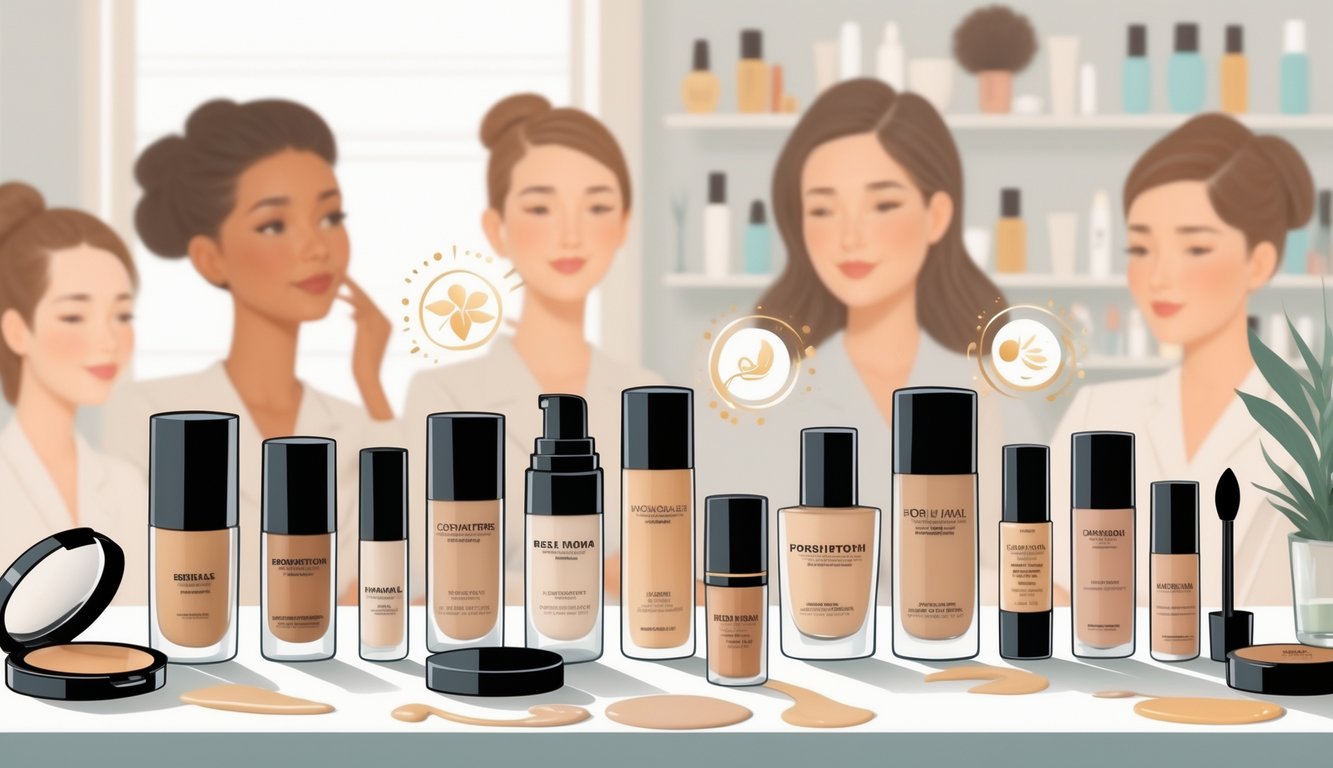Foundation Claims Beauty Editors Quietly Separate From Real Results
Popular Foundation Types and Their Promises

Pressed for time, always. None of these formulas ever blend as perfectly as the ads say, but they’re everywhere. Each type has its own set of promises—skin-perfecting, longwear, transfer-proof, hydrating, blurring—and every single one swears it’s “your skin but better.” Sure. Sometimes the truth isn’t even close.
Liquid Foundations
There’s a never-ending stream of liquid foundation launches—Gucci, Estée Lauder, NARS—all shouting about hydration, flawless finish, “second skin.” I tried Estée Lauder Double Wear; oil-free, supposed to be great for oily skin, but it got patchy after three hours. I don’t even sweat that much, so what gives? Dr. Sam Bunting (actual derm, not a PR puppet) quietly admits most “24-hour wear” claims can’t handle humidity. Still, Double Wear sells out for a reason.
The bottles list SPF 15, hyaluronic acid, peptides—stuff that sounds good, but who reapplies foundation every two hours? Session makeup artists will tell you: most liquids cover acne OR dryness, never both. Why do they all smell like paint? No one answers that.
Foundation Sticks
Things get weird here. Foundation sticks like Dior’s Forever Skin Perfect Foundation Stick are supposed to be effortless and mess-free. I’ve used them backstage and the “skin-like” finish only works if your skin is prepped to the gods—which, let’s be honest, most of us aren’t by noon. They melt at room temp and, honestly, melt off your face if you sneeze.
Denise Primbet says stick formulas are the best, but swipe too much and you look like you’re ready for drag night, too little and it’s invisible. Real talk: blend with fingers, then a brush, or deal with streaks. And no, they’re not travel-proof. The cap WILL fall off in your bag. Why does no one warn us?
Serum and Lightweight Foundations
Skipping heavy coverage, every serum foundation claims “skincare makeup.” Glossier’s Stretch Fluid Foundation brags about 89% skincare ingredients, hyaluronic acid, “undetectable coverage.” Watch someone pat it on—half evaporates before you cap the bottle. Has anyone ever covered redness in one coat without caking? I haven’t met them.
Serum and lightweight formulas almost always pill over sunscreen. Every review says “blends invisibly,” but in sunlight, every line and patch shows by lunch. “Natural” and “hydrating” just mean “less pigment, less coverage than tinted moisturizer”—that’s not what I signed up for. Somewhere, a creative director is probably cackling.
Longwear and High-End Foundations
So, “longwear.” YSL’s All Hours Luminous Matte Foundation, Givenchy’s Skin-Caring Matte—yeah, I’ve tried them both, and honestly, I’m calling their bluff. Twenty-four hours? Who are they kidding? I wore one through a wedding reception and then got stuck on a train in July—by hour four, my forehead was beaming like a disco ball. “Waterproof yet weightless,” they say. Sure, until you break a sweat or get caught in a breeze; then it’s just, poof, gone.
And don’t even start on the price tags. Forty bucks, sometimes more, and for what? I’ve talked to beauty editors who straight-up confess they touch up every three hours, and some even sneak back to their old drugstore favorites. Matte finish, high-end or not, always seems to find my pores or highlight every dry patch, even when I do the whole “prep” routine. Oh, and that “skin-caring” claim? Sometimes I wake up with a breakout—funny how you never see that in the reviews, just buried in the comments. “Suitable for all skin types”? Nope. That’s a fantasy.
Key Ingredients Beauty Editors Look For
Honestly, I can’t keep up with which “miracle” ingredient is supposed to change my life. Hydrators, antioxidants, weird fillers I can’t pronounce—does it even matter? I see “luminous finish” everywhere, but my cheeks are still patchy, so… what’s the point? Editors argue about it in every group chat. Meanwhile, celebrity endorsements roll in, but my skin doesn’t care who’s on the poster.
Moisturizers and Hydrators
Let’s be real—nobody wakes up with glassy, dewy skin unless they’re lying or have a ring light glued to their mirror. I’m always squinting at the ingredient list, stuck between the “hyaluronic acid” hype (which, let’s be honest, is sometimes just a sprinkle for marketing) and the boring, actually helpful stuff like glycerin or squalane. I’d rather have a foundation that sits right than one that promises to “moisturize” and then leaves me itchy by 2 p.m. Editors keep pushing “hydrating foundations” as their top picks, but if my face feels dry, I don’t care what’s trending.
Here’s a thing nobody mentions: water isn’t a moisturizer. It’s just there. I get way more out of foundations with lightweight oils or barrier-friendly emollients, especially since my eczema-prone skin throws a tantrum otherwise.
Antioxidants and Skin Benefits
Vitamin E, niacinamide—sure, editors get excited, but do I notice a difference? Not really. I’ve chased after “serum-foundation” hybrids like Ilia True Skin Serum Foundation, with all their aloe juice and squalane, but does it actually do anything? Maybe, maybe not. Some study says antioxidants help, but I’m not seeing fewer sunspots just because there’s vitamin E listed near the bottom.
And does anyone know if the antioxidants go in before or after the pigment? I don’t. I just end up layering my own serum underneath, because I trust that more than whatever “plant extract” they’re selling.
Potential Irritants or Sensitizers
Here’s what actually keeps me up at night—hidden irritants. Ask a dermatologist, or just try living with sensitive skin: fragrance, denatured alcohol, some silicones (dimethicone, looking at you) are why I sometimes have to hide my face for days. Editors love to say “safe for sensitive skin,” but “hypoallergenic” is basically a meaningless word unless a real lab tested it, not just some marketing intern.
Brands whisper about being non-comedogenic, then sneak in dyes and preservatives that break me out. “Foundation for sensitive skin” is a PR fantasy if the ingredient list is a novel. I’m always triple-checking for stuff like methylisothiazolinone or phenoxyethanol. And, by the way, nobody tells you the difference between a healthy flush and a full-blown histamine meltdown—until you’re bright pink and cursing your choices by noon.



